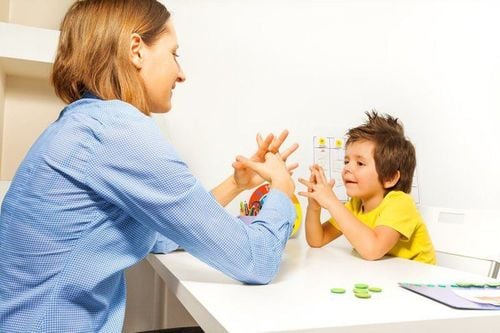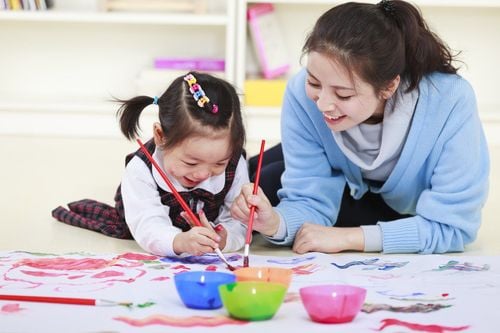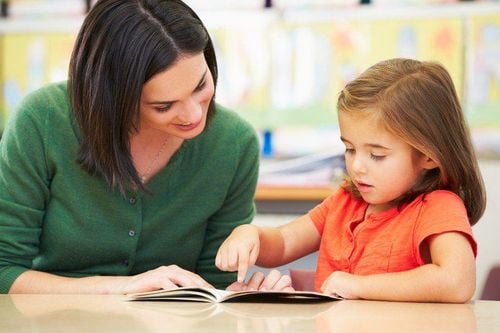This is an automatically translated article.
Teaching children how to share is an interesting and useful topic for parents, especially children under 2 years old. At this age, we often observe children seeming quite selfish, or in the words of many young people who are considered to be the guardians of wealth. So what causes children to have such expressions and how to teach them to share?1. Common symptoms in 2-year-old children
You might catch your 2-year-old daughter screaming "mine" and grabbing a playmate's doll one fine day. Or you might find your little 2-year-old screaming “no” when you pick up his favorite ball and roll it on the floor another day. You worry and think that your child is selfish and needs to re-educate him.However, in order to understand the child's actions, you need to understand the psychology of a 2-year-old child: Children act according to their age's perception of the world around, in which, interesting objects Children's toys are their own. 2-year-olds are beginning to form a certain understanding of ownership and are developing a strong sense of self, which makes "mine" and "no" their two favorite words.
Of course, there are some children who feel happy to share their favorite toy, but most children have the mindset of wanting to have more. In fact, children are not yet ready to share under the age of 2. Sure, if you keep an eye on them kids can play alongside other kids, but conflicts between kids can arise around give and take, so you should be mentally prepared.
Actually, children need to learn how to share and this takes time. You can start to introduce your child to the advantages of sharing, thereby building the foundation for this virtue in children as they grow older even though 2-year-olds are still quite young.
To teach 2-year-olds how to share, you can follow the steps below.
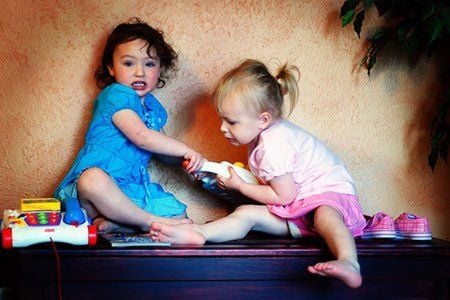
Trẻ 2 tuổi đang bắt đầu hình thành sự hiểu biết nhất định về sự sở hữu
2. How to teach 2-year-olds to share
Sharing is one of the necessary and important skills in life. To be able to make friends and maintain friendships, that is a virtue that young children need to learn and practice. Sharing also helps children to cooperate with other friends in playing, learning and later living and working in the community.Children will have to learn to share with others when entering a collective environment such as kindergartens, kindergartens, schools...
Children will be aware of compromise and fairness and help them learn We have learned that if children know how to give, they will receive (in a way and in some form that we do not expect) when they are taught about sharing. We easily see that is the law of life. live, even though this is not the purpose of learning to share.
In addition, children also learn how to negotiate, take turns (or take turns) and how to deal with frustration. These are all very important life skills when learned to share. This helps children gradually form tolerance and generosity towards everyone as they grow up.
2.1. Play with children in turn/turn game
Regularly have your child practice swapping or taking turns with you, such as the following:You turn a page in a book (it could be bedtime reading time), and then your child turns a page. Place the puzzle on your child's block and then it is their turn to place a block on top of yours. You and your child take turns putting the pieces. Or you can hug your child's teddy bear and then give it back to them. children hug and kiss. In addition, you can apply other games that children love and are interested in. These games help children understand sharing and help them understand that just because they give something to someone else doesn't mean they can never get it back.

Chia sẻ là một trong những kỹ năng cần thiết và quan trọng trong cuộc sống
2.2. Do not punish children when they are "stingy"
This is not the way to teach a 2-year-old if you tell your child that he is selfish and punish him for not sharing a toy with another child, or force him to hand over an item (a favorite object or toy that may be of interest to you). It can be very precious to your child, much less teaching your child to be generous, but you are inciting and encouraging anger in your childAccording to a PhD in development and psychology at George Mason University in Fairfax, Virginia – Susanne Denham you should never punish a child, especially a 2-year-old when he or she doesn't share it with others, because it's a very personal decision.
2.3. Let's talk with children
Talk to your child to help them discover the feelings involved in sharing. Explain to your child how his or her friend would feel if a child's friend keeps or takes back a certain toy. Help your child put his or her feelings into words.Also, when the child has loosened his grip, give him lots of praise. For example, at snack time, comment on how adorable your child and his friend were playing together and sharing cookies. Show them how much joy it can be to share with others.
2.4. Help your child practice sharing in small steps by cheering
The possessive attitude of 2-year-olds is sometimes expressed in an exaggerated way, even not wanting others to touch their things.By encouraging your child that she is cute for showing her toy, you can help her improve this situation. Your child will find it happier to share with others when he or she is supported by your praise.
2.5. Let's set up a playground for children
Let your kids put their favorite special toy somewhere else before their friends arrive, if you're planning a get-together for them and their friends. Put simple toys such as blocks, crayons and coloring books, costumes, clay, etc. in the play area. Tell your child and friends that they can share the toys and praise them when they do. Divert their attention with a question, snack, or other game, if one of them shows "possession" of a toy of their own.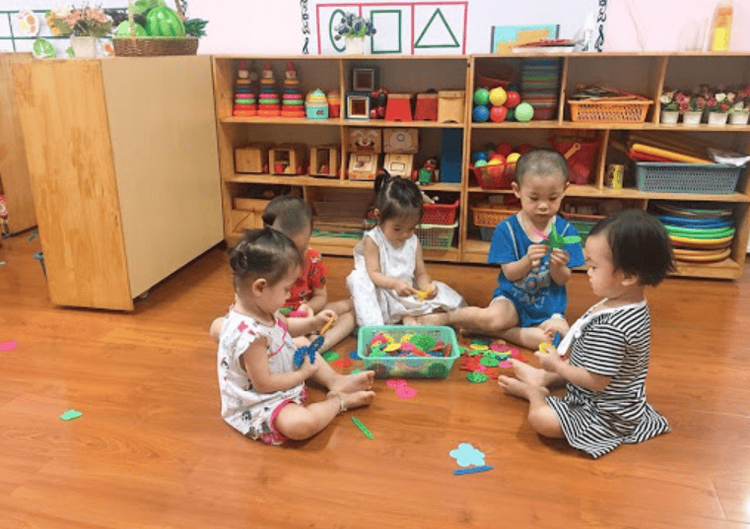
Hãy nói với trẻ rằng chúng có thể chia sẻ những món đồ chơi đó và khen ngợi khi trẻ thực hiện điều này
2.6. Respect children's belongings
If their toys, clothes, books, or colors are tampered with or freely used by others, it's not uncommon for a 2-year-old to not want to share those items with anyone.So you should first respect the child, before touching or borrowing something from them, you need to ask the child's opinion. Accept it and ask a sibling, friend, relative or nanny to do the same if your child says “no”.
2.7. Be a role model for your children
Even if you haven't taught your 2-year-old how to share, he'll probably imitate your actions.The best way for children to learn how to share and be generous with others is to let them see you do those things. So, you can teach your child with small everyday actions such as sharing the ice cream you are eating, lending your child your towel, or if you want to use your child's things, don't forget to ask your child first. . Don't forget to teach your kids that intangible things like feelings, thoughts or stories can also be shared, plus to describe what you're doing, use words to express sharing. .
During the time children are starting to learn, sharing can be quite a challenge. To develop this virtue, most children will need time and opportunity to practice.
You can practice with your child at home and talk about what you and your child are doing in case your child refuses to share.
When your child doesn't like to share toys, there's no reason not to let him play with other children. These playtimes should be viewed as opportunities for practice. During the time your child is playing with friends, you should stay by his side to remind and encourage him to not forget to share with other friends. Repeat exactly what your child does and how proud you would be to see him do so when he does these things.
Nurturing children's emotions is necessary, however, children in the developmental stage are also prone to respiratory problems, respiratory infections, skin diseases and infections. gastrointestinal tract ... parents need to pay special attention to the care and provision of adequate nutrition for children. For children to be healthy and develop well, it is necessary to have a nutritious diet in terms of quantity and quality balance. If children are not provided with adequate and balanced nutrients, it will lead to diseases of excess or lack of nutrients, which adversely affect the comprehensive development of children in terms of physical, mental and motor skills.
Parents should supplement their children with supportive products containing lysine, essential micro-minerals and vitamins such as zinc, chromium, selenium, and B vitamins to help fully meet their child's nutritional needs. At the same time, these essential vitamins also support digestion, enhance nutrient absorption, help improve anorexia, and help children eat well.
Parents can learn more:
Signs of zinc deficiency in children
Micronutrient deficiency and failure to gain weight in children
Please regularly visit Vinmec.com website and update useful information to take care of your child. Take care of the baby and the whole family.
Reference source: babycenter.com




